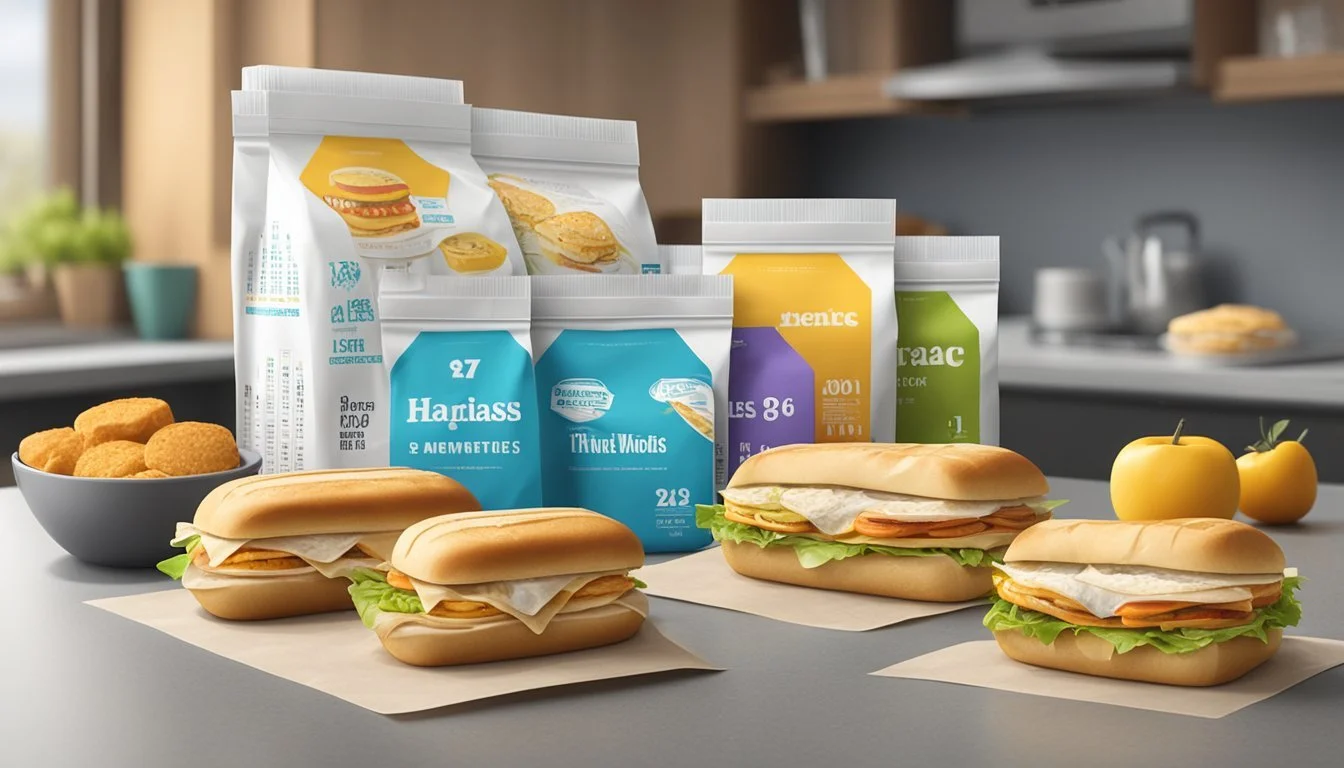How Long Do Breakfast Sandwiches Last?
Storage Tips and Shelf Life
Breakfast sandwiches offer a quick, convenient meal perfect for busy mornings. Understanding how long these sandwiches last can help minimize waste and maintain the best taste and texture. Homemade breakfast sandwiches can last anywhere from one to two months in the freezer if properly stored.
Proper storage techniques play a crucial role in maintaining the freshness of breakfast sandwiches. Wrapping each sandwich individually and tightly helps prevent freezer burn and keeps the ingredients from getting soggy. When ready to enjoy, reheating thoroughly ensures safety and the best possible flavor.
Knowing how long breakfast sandwiches last can transform your meal prep routine, making mornings smoother. Whether you prefer classic ingredients like eggs, cheese, and bacon or customize with your favorites, these tips ensure your breakfast stays fresh and delicious.
Understanding Breakfast Sandwiches
Breakfast sandwiches are a convenient and versatile meal option that can be easily customized with various ingredients and preparation methods. They are packed with essential nutrients, making them a popular choice for a quick and satisfying start to the day.
Ingredients and Variations
Breakfast sandwiches typically include eggs, cheese, and some type of bread like toast, bagels, or English muffins. Protein additions often feature bacon, sausage, or turkey sausage. For a healthier twist, ingredients such as spinach, mushrooms, and other veggies can be included.
They can be made at home or purchased from cafes and fast-food chains. Wraps and breakfast burritos are popular variations, often featuring whole wheat or low-carb wraps. Different types of cheese like cheddar, pepper jack, or swiss can also be chosen to enhance flavors. Homemade breakfast sandwiches give more control over ingredient quality and dietary preferences.
Nutritional Value
The nutritional content of a breakfast sandwich varies based on the ingredients. A typical sandwich contains protein from eggs and meat, important for muscle repair and growth. Cheese adds calcium and fat, essential for energy and cell function.
Common nutritional components include:
Calories: Can range from 300 to 600 depending on portion size.
Protein: Usually between 15 to 25 grams.
Fat: Contains 15 to 30 grams.
Saturated Fat: Around 5 to 10 grams.
Cholesterol: Eggs contribute to higher levels, typically between 150 to 250 mg.
Sodium: Can be high, ranging from 500 to 1,200 mg.
Carbohydrates: Mostly from bread, around 30 to 50 grams.
Fiber: Higher in whole grain options, 2 to 5 grams.
Varying ingredients can help control these values to meet specific dietary needs.
Common Types of Breakfast Sandwiches
Classic Egg and Cheese: A basic option with scrambled eggs and American cheese on toast or an English muffin.
Sausage and Egg: Features a sausage patty, egg, and cheddar on a bagel or muffin.
Bacon, Egg, and Cheese: Combines crispy bacon with egg and cheese, typically on a croissant or bagel.
Veggie Breakfast: Includes spinach, mushrooms, and other veggies with eggs and cheese on whole wheat toast.
Turkey Sausage and Egg White: A leaner version with turkey sausage, egg whites, and low-fat cheese on an English muffin.
Each type offers a unique taste and nutritional profile, catering to different preferences and dietary goals.
Storage Fundamentals
Proper storage ensures that breakfast sandwiches remain fresh and safe to eat. Key methods include refrigeration, freezing, and careful consideration for short-term countertop storage.
Freezer Storage Tips
Freezing breakfast sandwiches is a practical method to extend their shelf life. Wrap each sandwich individually in aluminum foil or parchment paper to prevent freezer burn. For added protection, place the wrapped sandwiches in a labeled Ziploc bag, removing as much air as possible before sealing.
Using a paper towel inside the wrapping can absorb moisture, preventing the bread from becoming soggy. When reheating, microwaving for two to three minutes is usually sufficient. Make-ahead freezer-friendly sandwiches can last up to one month, though they may lose some texture and flavor over time.
Refrigerator Lifespan
Refrigerating breakfast sandwiches keeps them fresh for a short period. Stored properly, these sandwiches can last three to five days. Wrapping each sandwich tightly in plastic wrap or placing them in an airtight container can help retain freshness.
Layering ingredients strategically can also impact quality; put cheese on the bottom layer close to the bread, followed by cooked eggs, and then vegetables closer to the top. Avoid direct application of condiments; use small packets instead to prevent sogginess.
Counter-Top Considerations
Leaving breakfast sandwiches at room temperature is practical for very short periods. They should not be left out for more than two to four hours to avoid bacterial growth and spoilage. If planning to store sandwiches on the countertop briefly, make sure they are not exposed to high temperatures.
Always use dry fillings, and avoid adding condiments until right before consuming. Keeping sandwiches wrapped in parchment paper can help maintain their integrity and prevent moisture from compromising the bread. Counter-top storage is generally best for immediate consumption.
Preparation Techniques
The process for making breakfast sandwiches that extend their shelf life involves understanding key steps in making, freezing, and reheating, along with utilizing specific kitchen equipment for optimal results.
Making Breakfast Sandwiches
To start, gather all necessary ingredients including eggs, cheese, and your choice of meats and vegetables. Begin by preheating the oven to 350°F if you plan to bake the eggs. Whisk eggs in a bowl, adding a bit of milk for fluffiness. Pour the mixture into a baking pan coated with cooking spray.
Bake the egg mixture for 15-20 minutes or until fully set. Meanwhile, toast the bread or English muffins lightly to prevent sogginess. Assemble the sandwiches by layering cheese, baked eggs, and other fillings. To avoid sogginess, keep condiments in small packets or add just before eating.
Freezing and Make-Ahead Methods
Once the sandwiches are assembled, wrap each one tightly in aluminum foil. Label the packages with the date to track freshness. Place them in a single layer on a baking sheet and freeze until solid. This prevents squishing.
For reheating, remove from the freezer and unwrap the foil. Microwave on a paper towel to absorb excess moisture, heating for 2-3 minutes. Alternatively, reheat for 20-30 minutes in a preheated oven at 325°F using a baking pan.
Recommended Cooking Equipment
Key kitchen tools streamline the preparation process. A whisk and bowl for mixing eggs are essential. An oven and baking pan facilitate even cooking of the egg mixture. Use a toaster for lightly preparing bread and a microwave or oven for reheating.
Cooking spray aids in easy release of baked eggs from the pan. Date labels and aluminum foil help in organizing and protecting the sandwiches during freezing. A well-equipped kitchen simplifies the breakfast sandwich-making process, ensuring they stay fresh and delicious.
Reheating and Serving
Properly reheating and serving breakfast sandwiches ensures they taste delicious and remain safe to eat. This includes thawing methods, reheating techniques, and creative serving ideas.
Safe Thawing Practices
When using frozen breakfast sandwiches, thawing can be done safely in the refrigerator overnight. This gradual defrosting maintains the food's integrity and prevents bacterial growth. If in a rush, sandwiches can be thawed using the microwave's defrost setting. Place the sandwich on a microwave-safe plate and use short time intervals to avoid cooking parts of it.
For best results, remove any aluminium foil before microwaving. Letting the sandwich cool slightly after thawing can help maintain texture and reduce sogginess.
Optimal Reheating Methods
Reheating methods vary based on available appliances.
For a toaster oven, preheat to 350°F (175°C). Place the sandwich on a baking sheet and heat for 8-10 minutes, ensuring the cheese melts and the entire sandwich warms through.
In a microwave, place the sandwich on a microwave-safe plate. Cover it with a paper towel to retain moisture. Heat on medium power for 1-2 minutes. Check the temperature to ensure it’s hot throughout.
For a stovetop method, use a skillet over medium heat. Flip the sandwich halfway to achieve even heating. Adding a bit of black pepper or warming with turkey bacon inside can enhance flavor.
Serving Suggestions
Make-ahead breakfast sandwiches are versatile and easily customizable. For a classic twist, serve on whole wheat English muffins with a side of fruit. Reheated sandwiches can also be served with a fresh salad or wrapped in lettuce for a lighter option.
Turmeric, paprika, or a slice of avocado can add both color and nutrition. For kids, cutting the sandwiches into smaller portions makes them fun and easy to eat.
Creative accompaniments can transform a simple reheated breakfast into an enjoyable meal, suitable for any time of day.






